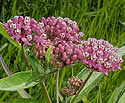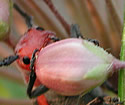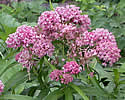Asclepias incarnata (Swamp Milkweed)
| Also known as: | Swamp Silkweed |
|---|---|
| Genus: | Asclepias |
| Family: | Apocynaceae (Dogbane) |
| Life cycle: | perennial |
| Origin: | native |
| Habitat: | sun; wet fields, swamps, along shores |
| Bloom season: | June - September |
| Plant height: | 1 to 4 feet |
| Wetland Indicator Status: | GP: FACW MW: OBL NCNE: OBL |
| MN county distribution (click map to enlarge): |  |
| National distribution (click map to enlarge): |  |
Pick an image for a larger view. See the glossary for icon descriptions.
Detailed Information
Flower: 

![[photo of flowers]](/udata/r9ndp23q/pd/asclepias-incarnata_4127869-t.jpg) 2 to 3-inch convex flower clusters at the top of the plant. Flowers are ¼-inch across with a 5-parted crown with a curved horn sticking out of each of the 5 cylindrical hoods in the crown, arching over the short column in the center. 5 downward-curved petals flare out beneath. Flower color ranges from pink to magenta to red, the central column of the star-shaped crown is usually cream colored.
2 to 3-inch convex flower clusters at the top of the plant. Flowers are ¼-inch across with a 5-parted crown with a curved horn sticking out of each of the 5 cylindrical hoods in the crown, arching over the short column in the center. 5 downward-curved petals flare out beneath. Flower color ranges from pink to magenta to red, the central column of the star-shaped crown is usually cream colored.
Leaves and stems: 

![[photo of leaves]](/udata/r9ndp23q/pink/swamp-milkweed_0816_160734-t.jpg) Leaves are up to 6 inches long and 1½ inches wide, hairless and toothless, tapering to a point at the tip on a short stalk; oppositely attached at the stem. Stems are mostly hairless but may have lines of fine hairs in the upper plant.
Leaves are up to 6 inches long and 1½ inches wide, hairless and toothless, tapering to a point at the tip on a short stalk; oppositely attached at the stem. Stems are mostly hairless but may have lines of fine hairs in the upper plant.
Fruit: 

![[photo of fruit]](/udata/r9ndp23q/pd/asclepias-incarnata-480938-3-t.jpg) Slender pods about 4 inches long containing many flat, brown seeds, each with a fuzzy parachute attached. When the pod splits open the seeds are carried away by the wind.
Slender pods about 4 inches long containing many flat, brown seeds, each with a fuzzy parachute attached. When the pod splits open the seeds are carried away by the wind.
Notes:
All Asclepias were formerly in family Asclepiadaceae but have been reassigned to Apocynaceae (Dogbane). Swamp milkweed can be easily distinguished from other milkweeds with pink flowers by its long narrow leaves. It grows easily in a home garden with average to moist soil—it is nearly exploding in my own back yard in heavy clay soil. Butterflies love it, and not just the Monarchs. Bees love it, too.
Native Plant Nurseries, Restoration and Landscaping Services ↓
More photos
 Swamp Milkweed plant
Swamp Milkweed plant milkweed beetle on Swamp Milkweed
milkweed beetle on Swamp Milkweed unusual white Swamp Milkweed flowers
unusual white Swamp Milkweed flowers garden grown Swamp Milkweed
garden grown Swamp Milkweed
Photos by K. Chayka taken at Vadnais/Snail Lake Regional Park, Ramsey County. Photos courtesy Peter M. Dziuk taken in a private garden in Anoka County.
Comments
Have you seen this plant in Minnesota, or have any other comments about it?
on: 2010-05-21 10:28:47
I find this plant all over the mississippi especially near boom island. I never knew what it was. Thanks.
on: 2010-09-06 21:23:22
I noticed a faint, pleasant fragrance from the flowers when I found some blooming by the Mississippi River earlier in the summer.
on: 2011-07-14 09:14:11
I live on Lake Gervais and there are several swamp milkweed plants starting to bloom. If I watch them closely could I harvest the seed pods and plant more along the shoreline?
on: 2011-07-14 10:53:25
Swamp milkweed should expand on its own, given the right conditions. Just spreading seed along the shore probably won't do much, as it is doing that naturally now. If you collect seed you might pot them up and replant once they germinate.
I have an explosion of it in my own back yard this year, in a highly disturbed area where it came up last year. Now it's too much, and needs some serious thinning. :)
on: 2012-07-31 08:50:07
This plant is blooming in two of my perennial flower beds. I left it because I didn't know what it was and was surprised when it bloomed with dusty pink flowers. There is a swamp behind my house and a lake in front.
on: 2012-09-30 19:53:05
I have a bunch of theses plants from a "mother" plant I got at highland nurshery. Very beautiful fall color, but yes its invasive, although native. They shouldn't be pulled up as they are native.
on: 2012-09-30 20:22:57
Just because it's native, doesn't mean you have to let it run wild! Judicious pruning and thinning of overzealous plants is not a bad thing :-) I have swamp milkweed in my own yard so I know it can take over if you let it. I do check for Monarch butterfly eggs before I yank it up, though, as this is a great host plant.
on: 2014-06-12 22:09:52
If you are looking to help the Monarchs, this is a great alternative to common milkweed for the suburban garden. They don't become weedy looking and spread mainly from seeds rather than underground roots. If they overcome your garden please share with your friends and neighbors. We can't waste a single milkweed plant!
on: 2014-07-22 16:15:57
I found a white variant of this growing in a patch of the pink flowered swamp milkweed on the north side of Wakefield Lake in Maplewood today.
on: 2014-08-05 14:58:42
I have a three year old large patch of swamp milkweed in the yard at Columbia Heights. Supposed to be good for the monarchs so I have left it. Need to get rid of it - only attracted flies this year! Seed heads are forming, will take it up North.
on: 2014-08-05 20:43:52
Kathleen, if I could only have 3 plants in my yard, swamp milkweed would be one of them. They are great for all kinds of pollinators, not just Monarchs. We always have a wide variety of bees, wasps, flies, beetles, and butterflies on ours. It does spread like crazy if you let it, but just remove the pods before they shed their seed and uproot the excess seedlings each year and it will stay in check.
on: 2014-08-10 07:55:46
These grow in almost every ditch and field here, but they prefer moist ground, my niece calls them cinnamon plant, because that's what they smell like to her, they do smell good!.
on: 2014-08-21 14:21:22
My mistake, my patch of milkweed is "common", not swamp. I am trying to establish the swamp. I took the common plants with their seed heads and distributed them on my property near Bigfork. Anybody know, do I need to dig out all roots to stop it in my yard? I have removed all seed pods before they open, but it has not slowed the growth. They do smell wonderful in bloom!
on: 2014-08-21 20:23:40
Kathleen, common milkweed spreads vegetatively by creeping rhizomes as well as by seed. Uproot excess plants and remove the pods to keep it in check.
on: 2015-05-06 16:33:08
Where can I purchase swamp milkweed plants -- in pots? Thanks.
on: 2015-05-06 22:44:53
Rolfe, see "where to buy native seed and plants" that's on almost every page of the website.
on: 2015-07-16 19:30:06
Even though Tod county is not highlighted on the map, I have found this plant along the Sauk River, by Little Sauk.
on: 2016-01-29 15:51:46
My wife and I just received a couple packages of seed from our employer, Andersen Windows. They have signed the Pollinator Pledge to improve habitat along the St Croix corridor. While we live in southern Cottage Grove, we do have a lot of pollinating creatures. I'm concerned about keeping it wet enough. We will see what happens, but with February on the horizon, it'll be awhile.
on: 2016-05-25 04:31:50
I will gladly pay anyone to harvest this plant and deliver it to me email me if interested. Thank you for your time
on: 2016-05-25 06:07:27
Eric, go buy some seed - it's readily available by mail order.
on: 2016-05-28 16:58:33
Milkweed has popped up on our property largely in the past few years. We live in a farming community with our backyard meeting up to a gravel pit. The soil in our yard and the back hill into to the pit Is clay-based. The nearest lake is 15 miles away. They are starting to inhabit the raised garden we started 15 years ago. I use a spade to dig out the sprouts as they appear but have yet to get far enough down to find the start of the roots. I've dug as deep as 15" and still end up breaking the crisp white stem!
on: 2017-07-21 09:12:55
I found one plant growing on the waters edge , near the path that runs parallel with Minnetonka blvd. I love discovering all the different varieties of milkweed. This one was brilliantly colored!
on: 2019-07-11 17:36:13
Growing wild at the lake by the house. Couple of monarch caterpillars happily munching away.
on: 2020-03-30 05:51:58
Common around the lakeshore and pond edges here in Dakota county and a valuable food source monarch caterpillars. The thick white roots are adapted to damp heavy soils. A good garden subject when watered during dry spells or used in a rain garden or damp areas. Our plants are often fed upon by yellow-orange aphids that feed on the lower stems and roots. Easily grown from seed, especially if the seed has been dried for a year or two, fresh seed has dormancy issues that need a cool moist period to break. A valuable species for Monarch butterflies both as adults and larva and small native bees. Not eaten by deer around here very often in summer but feed upon in the spring as the shoots grow.
on: 2020-09-14 19:08:36
Received a plant from a friend, decided to throw a bunch of seeds on the ground and ended up with way too many. I dug those out and now have 2 clumps that I keep, always removing the seed pods before the seeds emerge from the pod. They do not need as much moisture as their reputation claims; it can get very dry for long periods of time here and they always perform. I get those orange aphids, too.
on: 2020-09-29 13:43:11
Common in Crow Wing County; growing in Northland Arboretum and around shoreline of Black Hoof Lake for example.
on: 2022-01-21 18:30:05
This species just showed up one summer at my place many years ago. It has spread in the garden where it is much appreciated by monarch butterflies. The flowers are fragrant and smell a bit like chocolate.
on: 2023-07-21 12:40:41
Ive grown swamp milkweed for years as it travelled around my yard. This year one plant, in a new spot, sprouted all white flowers! Is it a natural mutation or a drop in from elsewhere??
on: 2023-07-21 15:53:24
Kathleen, white flowers would be a natural variation that may or may not persist.
on: 2023-08-08 11:35:08
I have them on my property along the swampy River I live by. I use Google Lens and they also look similar to something called Jo Pye Weed. Any ideas?
on: 2023-08-08 12:16:39
Jocelyn, a close-up of the individual flowers shows milkweed and joe-pye weed don't really look anything alike, plus the leaves are very different between the two.






